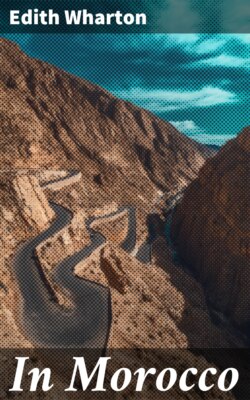In Morocco

Реклама. ООО «ЛитРес», ИНН: 7719571260.
Оглавление
Edith Wharton. In Morocco
In Morocco
Table of Contents
PREFACE
I
II
NOTE
ILLUSTRATIONS
I
RABAT AND SALÉ
I. LEAVING TANGIER
II. THE TRAIL TO EL-KSAR
III. EL-KSAR TO RABAT
IV. THE KASBAH OF THE OUDAYAS
V. ROBINSON CRUSOE'S "SALLEE"
VI. CHELLA AND THE GREAT MOSQUE
FOOTNOTES:
II
VOLUBILIS, MOULAY IDRISS AND MEKNEZ
I. VOLUBILIS
II. MOULAY IDRISS
III. MEKNEZ
FOOTNOTES:
III
FEZ
I. THE FIRST VISION
II. FEZ ELDJID
III. FEZ ELBALI
IV. EL ANDALOUS AND THE POTTERS' FIELD
V. MEDERSAS, BAZAARS AND AN OASIS
VI. THE LAST GLIMPSE
FOOTNOTES:
IV
MARRAKECH
I. THE WAY THERE
II. THE BAHIA
III. THE BAZAARS
IV. THE AGDAL
V. ON THE ROOFS
VI. THE SAADIAN TOMBS
FOOTNOTES:
V
HAREMS AND CEREMONIES
I. THE CROWD IN THE STREET
II. AÏD-EL-KEBIR
III. THE IMPERIAL MIRADOR
IV. IN OLD RABAT
V. IN FEZ
VI. IN MARRAKECH
FOOTNOTES:
VI
GENERAL LYAUTEY'S WORK IN MOROCCO
I
II
III
THE WORK OF THE FRENCH PROTECTORATE, 1912–1918. PORTS
COMMERCE. COMPARATIVE TABLES
ROADS BUILT
RAILWAYS BUILT
LAND CULTIVATED
JUSTICE
EDUCATION
MEDICAL AID
FOOTNOTES:
VII
A SKETCH OF MOROCCAN HISTORY
I. THE BERBERS
II. PHENICIANS, ROMANS AND VANDALS
III. THE ARAB CONQUEST
IV. ALMORAVIDS AND ALMOHADS
V. THE MERINIDS
VI. THE SAADIANS
VII. THE HASSANIANS
FOOTNOTES:
VIII
NOTE ON MOROCCAN ARCHITECTURE
I
II
III
IV
FOOTNOTES:
IX
BOOKS CONSULTED
INDEX
BY EDITH WHARTON
Отрывок из книги
Edith Wharton
Published by Good Press, 2019
.....
Between these nomad colonies lies the bled, the immense waste of fallow land and palmetto desert: an earth as void of life as the sky above it of clouds. The scenery is always the same; but if one has the love of great emptinesses, and of the play of light on long stretches of parched earth and rock, the sameness is part of the enchantment. In such a scene every landmark takes on an extreme value. For miles one watches the little white dome of a saint's grave rising and disappearing with the undulations of the trail; at last one is abreast of it, and the solitary tomb, alone with its fig-tree and its broken well-curb, puts a meaning into the waste. The same importance, but intensified, marks the appearance of every human figure. The two white-draped riders passing single file up the red slope to that ring of tents on the ridge have a mysterious and inexplicable importance: one follows their progress with eyes that ache with conjecture. More exciting still is the encounter of the first veiled woman heading a little cavalcade from the south. All the mystery that awaits us looks out through the eye-slits in the grave-clothes muffling her. Where have they come from, where are they going, all these slow wayfarers out of the unknown? Probably only from one thatched douar[1] to another; but interminable distances unroll behind them, they breathe of Timbuctoo and the farthest desert. Just such figures must swarm in the Saharan cities, in the Soudan and Senegal. There is no break in the links: these wanderers have looked on at the building of cities that were dust when the Romans pushed their outposts across the Atlas.
A town at last—its nearness announced by the multiplied ruts of the trail, the cactus hedges, the fig-trees weighed down by dust leaning over ruinous earthern walls. And here are the first houses of the European El-Ksar—neat white Spanish houses on the slope outside the old Arab settlement. Of the Arab town itself, above reed stockades and brown walls, only a minaret and a few flat roofs are visible. Under the walls drowse the usual gregarious Lazaruses; others, temporarily resuscitated, trail their grave-clothes after a line of camels and donkeys toward the olive-gardens outside the town.
.....